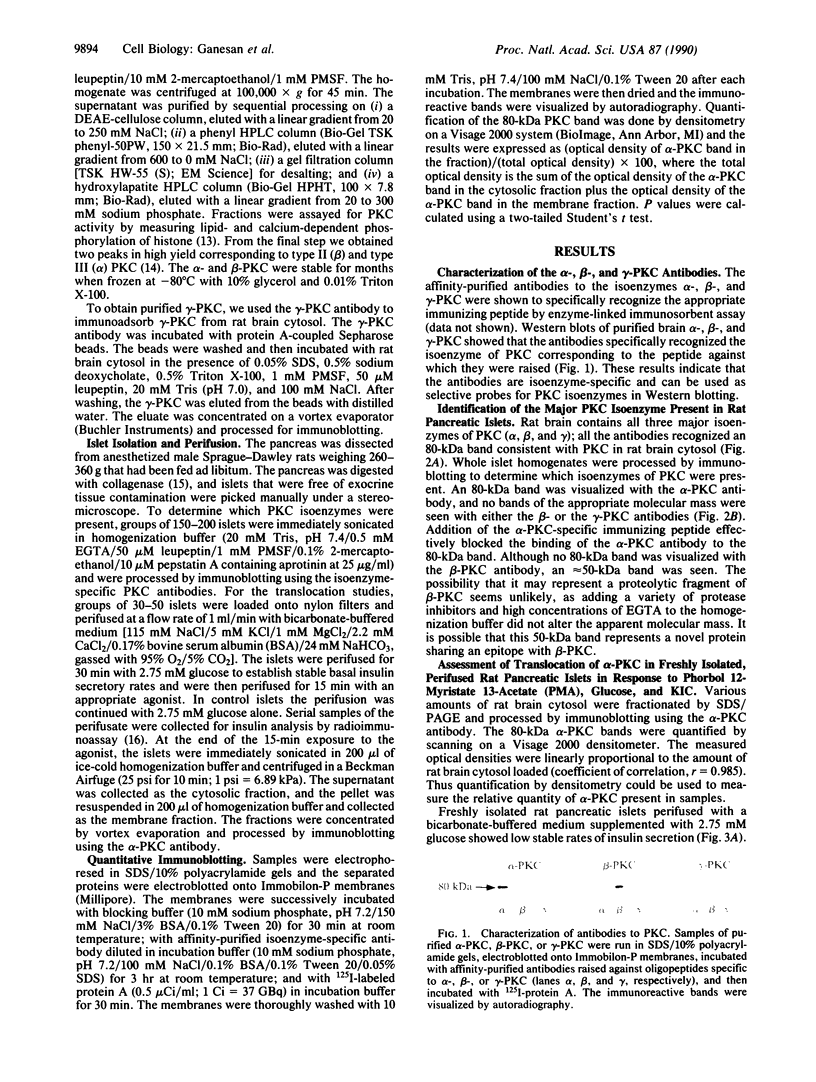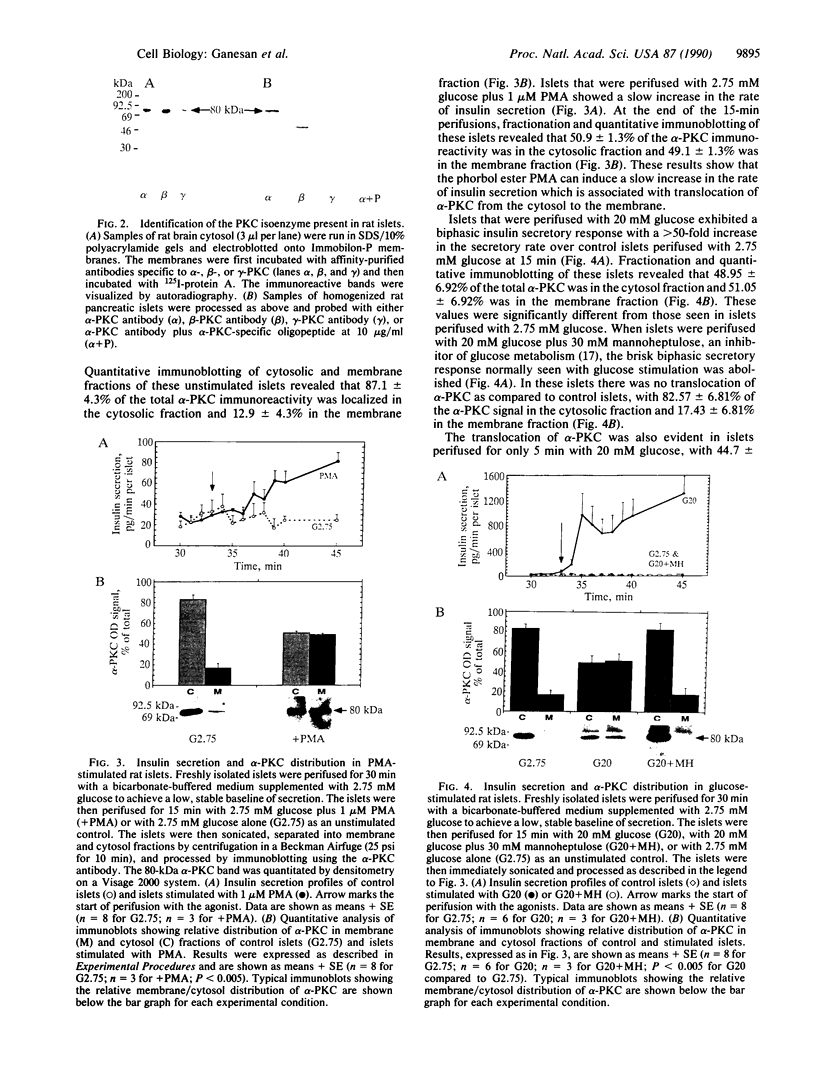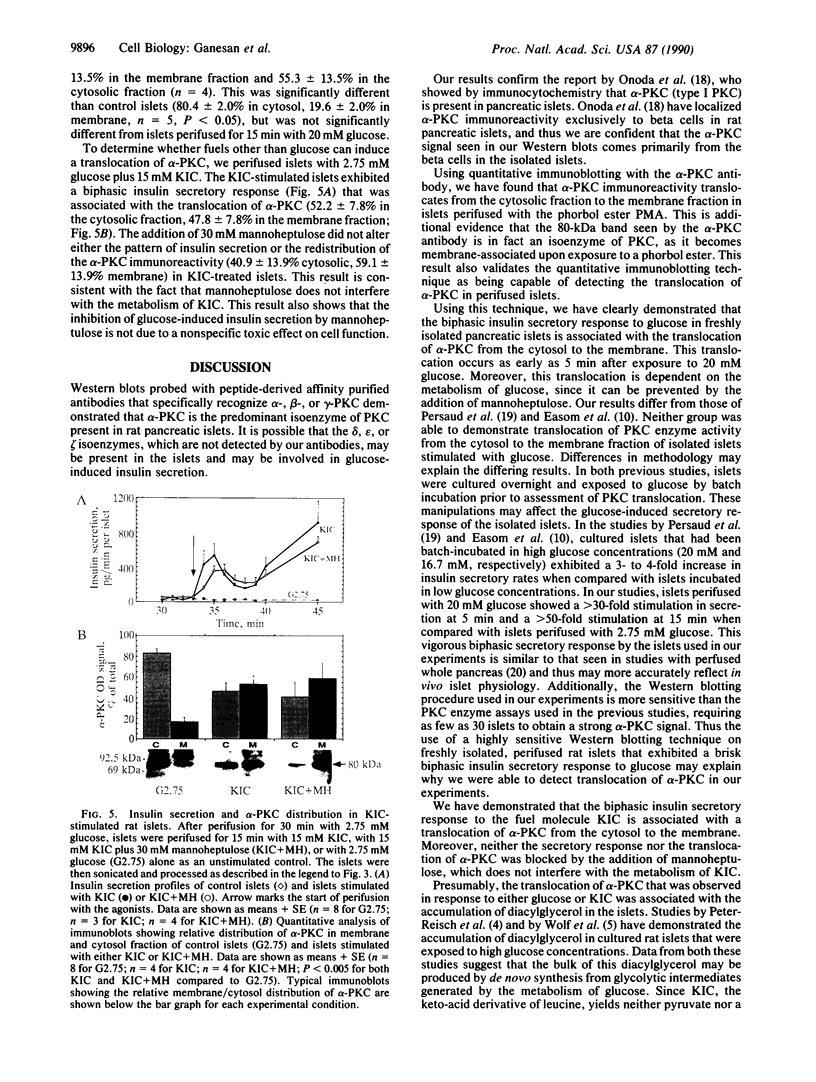Abstract
The role of protein kinase C (PKC) as a mediator of glucose-induced insulin secretion has been a subject of controversy. Glucose-induced translocation of PKC has not been reported, and the relevant PKC isoenzymes in islets have not been identified. To address these issues, we developed specific antibodies to the alpha, beta, and gamma isoenzymes of PKC. Western blots of homogenates of freshly isolated rat islets probed with these antibodies revealed that the major isoenzyme present is alpha-PKC. Islets were perifused for 15 min with either 2.75 mM glucose, 20 mM glucose, 20 mM glucose plus 30 mM mannoheptulose, 15 mM alpha-ketoisocaproate, or alpha-ketoisocaproate plus mannoheptulose. Quantitative immunoblotting of membrane and cytosol fractions showed that alpha-PKC translocated from the cytosol to the membrane in freshly isolated rat islets stimulated with either 20 mM glucose or 15 mM alpha-ketoisocaproate. Both the secretory response and the translocation of alpha-PKC were blocked by the addition of mannoheptulose, an inhibitor of glucose metabolism, in islets stimulated with glucose but not in islets stimulated with alpha-ketoisocaproate. These results support a role for alpha-PKC in mediating glucose-induced insulin secretion in pancreatic islets.
Full text
PDF




Images in this article
Selected References
These references are in PubMed. This may not be the complete list of references from this article.
- Albano J. D., Ekins R. P., Maritz G., Turner R. C. A sensitive, precise radioimmunoassay of serum insulin relying on charcoal separation of bound and free hormone moieties. Acta Endocrinol (Copenh) 1972 Jul;70(3):487–509. doi: 10.1530/acta.0.0700487. [DOI] [PubMed] [Google Scholar]
- Arkhammar P., Nilsson T., Welsh M., Welsh N., Berggren P. O. Effects of protein kinase C activation on the regulation of the stimulus-secretion coupling in pancreatic beta-cells. Biochem J. 1989 Nov 15;264(1):207–215. doi: 10.1042/bj2640207. [DOI] [PMC free article] [PubMed] [Google Scholar]
- Castagna M., Takai Y., Kaibuchi K., Sano K., Kikkawa U., Nishizuka Y. Direct activation of calcium-activated, phospholipid-dependent protein kinase by tumor-promoting phorbol esters. J Biol Chem. 1982 Jul 10;257(13):7847–7851. [PubMed] [Google Scholar]
- Easom R. A., Hughes J. H., Landt M., Wolf B. A., Turk J., McDaniel M. L. Comparison of effects of phorbol esters and glucose on protein kinase C activation and insulin secretion in pancreatic islets. Biochem J. 1989 Nov 15;264(1):27–33. doi: 10.1042/bj2640027. [DOI] [PMC free article] [PubMed] [Google Scholar]
- Gerich J. E., Charles M. A., Grodsky G. M. Characterization of the effects of arginine and glucose on glucagon and insulin release from the perfused rat pancreas. J Clin Invest. 1974 Oct;54(4):833–841. doi: 10.1172/JCI107823. [DOI] [PMC free article] [PubMed] [Google Scholar]
- Huang K. P., Nakabayashi H., Huang F. L. Isozymic forms of rat brain Ca2+-activated and phospholipid-dependent protein kinase. Proc Natl Acad Sci U S A. 1986 Nov;83(22):8535–8539. doi: 10.1073/pnas.83.22.8535. [DOI] [PMC free article] [PubMed] [Google Scholar]
- Lacy P. E., Kostianovsky M. Method for the isolation of intact islets of Langerhans from the rat pancreas. Diabetes. 1967 Jan;16(1):35–39. doi: 10.2337/diab.16.1.35. [DOI] [PubMed] [Google Scholar]
- Lord J. M., Ashcroft S. J. Identification and characterization of Ca2+-phospholipid-dependent protein kinase in rat islets and hamster beta-cells. Biochem J. 1984 Apr 15;219(2):547–551. doi: 10.1042/bj2190547. [DOI] [PMC free article] [PubMed] [Google Scholar]
- Makowske M., Ballester R., Cayre Y., Rosen O. M. Immunochemical evidence that three protein kinase C isozymes increase in abundance during HL-60 differentiation induced by dimethyl sulfoxide and retinoic acid. J Biol Chem. 1988 Mar 5;263(7):3402–3410. [PubMed] [Google Scholar]
- Metz S. A. Perspectives in diabetes. Is protein kinase C required for physiologic insulin release? Diabetes. 1988 Jan;37(1):3–7. doi: 10.2337/diab.37.1.3. [DOI] [PubMed] [Google Scholar]
- Nishizuka Y. The molecular heterogeneity of protein kinase C and its implications for cellular regulation. Nature. 1988 Aug 25;334(6184):661–665. doi: 10.1038/334661a0. [DOI] [PubMed] [Google Scholar]
- Nishizuka Y. The role of protein kinase C in cell surface signal transduction and tumour promotion. Nature. 1984 Apr 19;308(5961):693–698. doi: 10.1038/308693a0. [DOI] [PubMed] [Google Scholar]
- Onoda K., Hagiwara M., Hachiya T., Usuda N., Nagata T., Hidaka H. Different expression of protein kinase C isozymes in pancreatic islet cells. Endocrinology. 1990 Feb;126(2):1235–1240. doi: 10.1210/endo-126-2-1235. [DOI] [PubMed] [Google Scholar]
- Persaud S. J., Jones P. M., Sugden D., Howell S. L. Translocation of protein kinase C in rat islets of Langerhans. Effects of a phorbol ester, carbachol and glucose. FEBS Lett. 1989 Mar 13;245(1-2):80–84. doi: 10.1016/0014-5793(89)80196-6. [DOI] [PubMed] [Google Scholar]
- Peter-Riesch B., Fathi M., Schlegel W., Wollheim C. B. Glucose and carbachol generate 1,2-diacylglycerols by different mechanisms in pancreatic islets. J Clin Invest. 1988 Apr;81(4):1154–1161. doi: 10.1172/JCI113430. [DOI] [PMC free article] [PubMed] [Google Scholar]
- Prentki M., Matschinsky F. M. Ca2+, cAMP, and phospholipid-derived messengers in coupling mechanisms of insulin secretion. Physiol Rev. 1987 Oct;67(4):1185–1248. doi: 10.1152/physrev.1987.67.4.1185. [DOI] [PubMed] [Google Scholar]
- Rasmussen H., Zawalich K. C., Ganesan S., Calle R., Zawalich W. S. Physiology and pathophysiology of insulin secretion. Diabetes Care. 1990 Jun;13(6):655–666. doi: 10.2337/diacare.13.6.655. [DOI] [PubMed] [Google Scholar]
- Smallwood J. I., Gügi B., Rasmussen H. Regulation of erythrocyte Ca2+ pump activity by protein kinase C. J Biol Chem. 1988 Feb 15;263(5):2195–2202. [PubMed] [Google Scholar]
- Smith P. A., Rorsman P., Ashcroft F. M. Modulation of dihydropyridine-sensitive Ca2+ channels by glucose metabolism in mouse pancreatic beta-cells. Nature. 1989 Nov 30;342(6249):550–553. doi: 10.1038/342550a0. [DOI] [PubMed] [Google Scholar]
- Thomas T. P., Ellis T. R., Pek S. B. Insulin release in RINm5F cells and glyceraldehyde activation of protein kinase C. Diabetes. 1989 Nov;38(11):1371–1376. doi: 10.2337/diab.38.11.1371. [DOI] [PubMed] [Google Scholar]
- Wolf B. A., Easom R. A., Hughes J. H., McDaniel M. L., Turk J. Secretagogue-induced diacylglycerol accumulation in isolated pancreatic islets. Mass spectrometric characterization of the fatty acyl content indicates multiple mechanisms of generation. Biochemistry. 1989 May 16;28(10):4291–4301. doi: 10.1021/bi00436a026. [DOI] [PubMed] [Google Scholar]
- Zawalich W. S., Dye E. S., Rognstad R., Matschinsky F. M. On the biochemical nature of triose- and hexose-stimulated insulin secretion. Endocrinology. 1978 Dec;103(6):2027–2034. doi: 10.1210/endo-103-6-2027. [DOI] [PubMed] [Google Scholar]
- Zawalich W. S. Time-dependent potentiation of insulin release induced by alpha-ketoisocaproate and leucine in rats: possible involvement of phosphoinositide hydrolysis. Diabetologia. 1988 Jul;31(7):435–442. doi: 10.1007/BF00271588. [DOI] [PubMed] [Google Scholar]
- Zawalich W. S., Zawalich K. C. Phosphoinositide hydrolysis and insulin release from isolated perifused rat islets. Studies with glucose. Diabetes. 1988 Sep;37(9):1294–1300. doi: 10.2337/diab.37.9.1294. [DOI] [PubMed] [Google Scholar]
- Zawalich W., Brown C., Rasmussen H. Insulin secretion: combined effects of phorbol ester and A23187. Biochem Biophys Res Commun. 1983 Dec 16;117(2):448–455. doi: 10.1016/0006-291x(83)91221-4. [DOI] [PubMed] [Google Scholar]
- Zawalich W., Zawalich K., Rasmussen H. Insulin secretion: combined tolbutamide, forskolin and TPA mimic action of glucose. Cell Calcium. 1984 Dec;5(6):551–558. doi: 10.1016/0143-4160(84)90031-9. [DOI] [PubMed] [Google Scholar]







